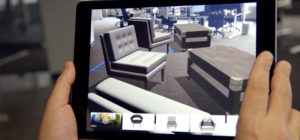
What’s the ARKit fanfare all about?
The launch of Apple’s ARKit software, which makes it easier for developers to create AR applications that fully harness the iPhone’s hardware, motivated several top retailers to up-level their investment in AR and 3D products. Tuesday’s release of iOS11 was followed by major retailers touting their new ARKit experiences. These include:
Ikea Place
In addition to partnering with Apple to have IKEA Place in the App Store at the launch of iOS11, IKEA got stage time at the widely seen Worldwide Developer Conference in June. IKEA’s app features clean models and impressive object stability courtesy of the ARKit framework.
WayFair ARKit App
The WayFair mobile app already had a “faux-AR” view, where users could pull up a flat-looking image of an item and view it in atop a video feed of the real space. With the addition of ARKit support, WayFair is now able to showcase fully 3D models of products. The difference is stunning.
Anthropologie ARKit app
Noticing a trend yet? Yes, homegoods retailers have been jumping into AR with abandon. Anthropologie is doing more than keeping up with the competition, though, and their stylish and tasteful app suits their brand and public image.
With ARKit, Augmented Reality retail has gone from niche to necessity

Long a niche technology, Augmented Reality (AR) is now on the cusp of achieving overwhelming mainstream adoption. In the past 24 hours alone, announcements from four major retailers — Ikea, WayFair, Houzz and Anthropologie — have taken Augmented Reality retail from flight of fancy to a full-on necessity for retailers. Apple, Google and Microsoft have all embraced AR, creating software toolkits (ARKit, ARCore) and new hardware (Microsoft’s HoloLens) to better show off the technology. An army of developers is massing to build the next generation of mobile apps, leveraging AR to change the way users interact with their devices and the world around them.
AR’s big breakthrough is the most exciting moment for smartphones since Steve Jobs took the wraps off the original iPhone in 2007. But leaving aside the current hype, AR apps are not new, even if their functionality has come a long way in recent years. A short 5 years ago, a state of the art AR app was limited to a marker-based “point and see” experience, where the user would hold a device over, say, a magazine advertisement encoded with an animated character that seemed to emerge from the printed page and skitter across the table. Eye-catching for sure, but not very useful as a sales tool.
Today’s retailers are recognizing the power of AR to drive sales, show off extensive product lines, and increase customer satisfaction and loyalty. That said, companies often encounter a steep learning curve when first trying to develop a satisfying AR experience for customers. It’s one of the main reasons Apple developed and released their ARKit SDK.
Nine things to know before building an ARKit retail app
So you’re not Ikea or Anthropologie, but you are aware of ARKit and have your eye on using it to amplify your omnichannel strategy. Whether this will be your first foray into AR, or your business has been developing AR-based campaigns in house for years, there are certain “must-haves” that need to be included for any AR app to shine in what will quickly become a crowded marketplace. Here are nine things to consider when getting started:
1. It’s not just about today – this is the future of shopping
What’s experimental now will be essential later, and today’s cutting edge solutions are fated to be tomorrow’s slow legacy tech. Retailers have to be forward-thinking and plan ahead, while also realizing that technologies like AR and VR are here to stay even if the devices we use to view them are not. If you’re a retailer dealing with related products or more than a few dozen SKUs, you have to be thinking about portability, content relationships, merchandising, and finding a solution that will work for you today, tomorrow, next quarter and next year.
2. An omnichannel investment in 3D content will pay off
Retailers already use 3D models for a wide variety of products and implementations. These 3D models MUST be available across platforms and devices — be it an smartphone app, tablet app, VR experience, Web app built on WebGL, in-store touchscreen showroom experience, or some other technology. Customers demand a consistent experience, and it’s key to ensure that the best possible version of your product is available wherever a customer might look for it. There are also asset decay cycles to contend with, as some items need to be retired every few months. Smart retailers will figure out which products need to be converted to 3D models, whether those SKUs should be evergreen or seasonal (and if seasonal, how often they need to be replaced), and how to deploy those assets across channels. The right content management system will be vital to managing a growing 3D product catalog and diverse set of shopper experiences.
3. Go beyond the bare minimum: Invest in composition or interest will quickly fade
There’s more to AR than just placing a single object into a real context — that’s never been how shoppers shop or retailers achieve margin. For retailers seeking out a multiple unit sales strategy, your ARKit app must allow shoppers to place multiple 3D product models into a scene, and then move around the scene with the models staying fixed firmly in place. The user should be able to re-arrange the items, adding and removing them at will. The AR application also needs to be linked to a cloud-based content management system that organizes and serves the 3D models to the app on demand and in real time.
4. Invest in assembly
Assembly is a back-end process in which content managers create product packages from a wide selection of different items and customizations, by deciding what rules govern the assembly process and how the individual product parts fit together. For example, picture an app showcasing bathroom renovation products. The user can swap out sinks, toilets, tubs, cabinets, color schemes and fixtures. But there are bound to be real-world limitations — certain faucets will only go with specific sinks, or some hardware only fits a specific make and model of cabinet — and the rules that govern this must be specified ahead of time.
5. Embrace Diminished Reality, field of view, and other features consumers crave
Until now, Augmented Reality has focused on adding 3D content to real world scenes. Next-generation AR experiences are going to take this a step farther by allowing users to remove real items from scenes. It’s called “Diminished Reality,” and it gives users control of their space like never before. In today’s apps, users will often place a 3D model over a real-world counterpart. You see this in furniture apps, where a shopper is previewing a couch in their living room — but there’s already a real couch sitting there. The user can place the digital couch over the real one, but the effect is imperfect — with the existing furniture peaking out from the edges of the 3D model. A system capable of Diminished Reality will first remove the real couch, and then draw the 3D model where the physical object used to be. It’s not magic, but it’s close.
6. Get to know procedural content
As AR sales experiences get more complex, and retailers offer more and more products and product combinations, AR applications are going to bog down trying to load thousands of pre-rendered models. One solution is to utilize procedural content created on the fly, rather than leaning exclusively on pre-rendered 3D assets. For example, a customer remodeling their kitchen cabinets can choose from a wide variety of customizations — everything from wood type and color scheme, to hardware like handles and hinges. Creating 3D models of every conceivable product assembly would be cost and time prohibitive, but a system capable of producing procedural content can handle billions of permutations in the blink of an eye. That increases efficiency and decreases the processing power necessary to deliver a first class AR experience.
7. Go wide! Address the largest possible market without limiting audience size
Niches are great, but retailers are in business to service the widest range of customers possible. It’s not enough to build the be-all end-all of AR applications if that app only lives on a platform that a few people can access. The world’s most amazing ARKit app is useless to the tens of millions of Americans who own an Android phone. A baller ARCore experience won’t run on an iPhone. However, there are other solutions out there that can service both platforms. It’s up to the retailer to find the one that’s right for them and the market they’re hoping to reach.
8. Support a range of operating systems and hardware platforms
For a retailer’s digital shopping strategy to pay off, it must be available to customers however and wherever they shop. Retailers have long sought an omnichannel strategy that put their products in front of customers across a multitude of sales channels, but these experiences are often fragmented — with different products available in different locations, or other inconsistencies in the sales process. Whatever the plan, retailers want their solutions to be uniformly pleasant across implementations, and deliver a consistent and reliable branded experience to customers — be they in the store, surfing the Web, pecking at a smartphone app, or swiping through products on a touchscreen showroom kiosk placed in a high-traffic area.
9. Get Real! Create a “sense of presence”
Seeing is believing — and converting. The more realistic the 3D content, the more convincing it will be to shoppers. Achieving the type of realism that’s convincing to shoppers involves attention to detail in lighting and textures. But when a retailer is successful in creating a sense of presence for its 3D products, it becomes the ultimate in “try before you buy” experience — all without the added expense of costly samples. Even better: Customers who experience a product in their home with AR report a higher degree of post-sale satisfaction, and higher satisfaction means low returns and higher profits for retailers.










